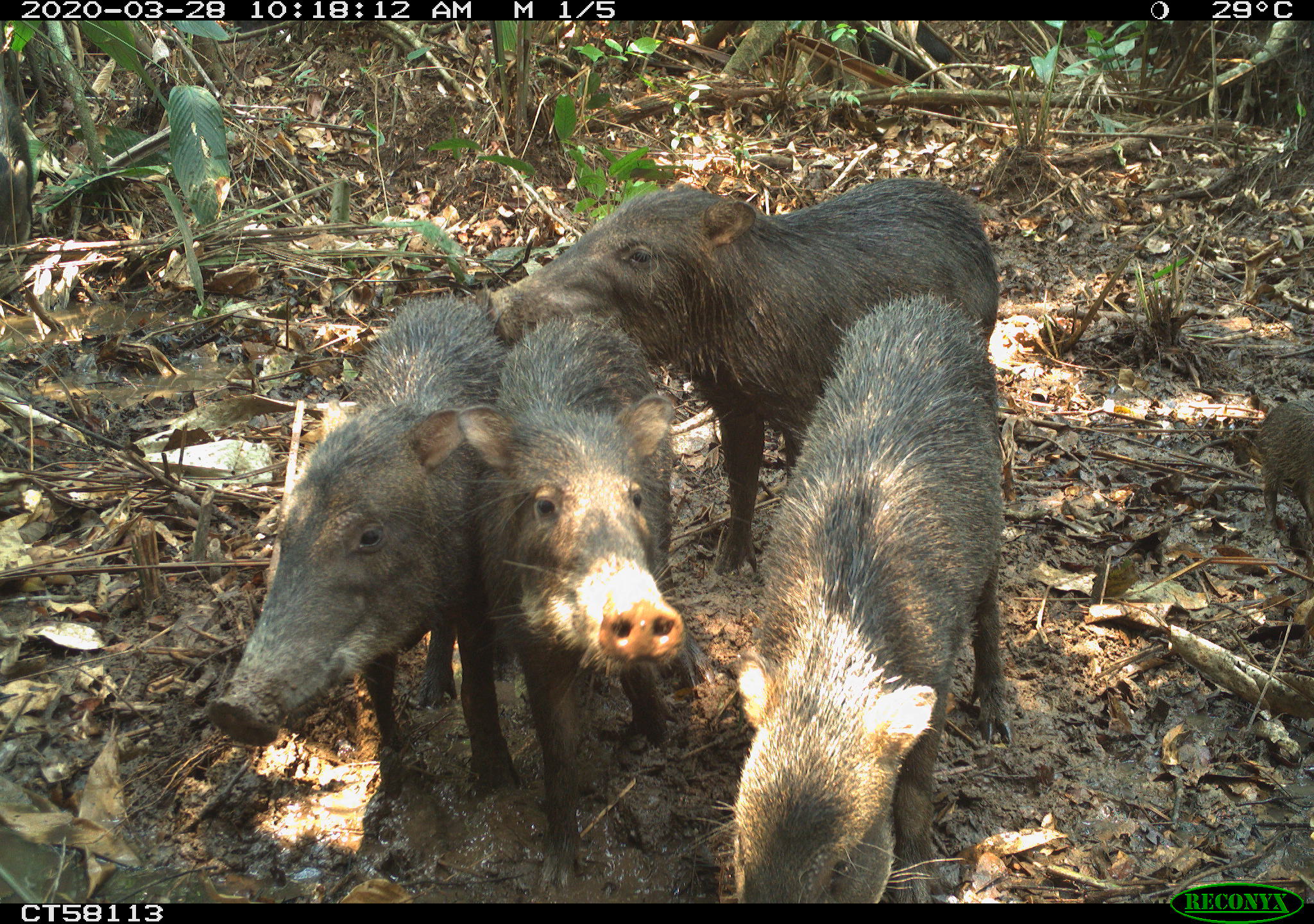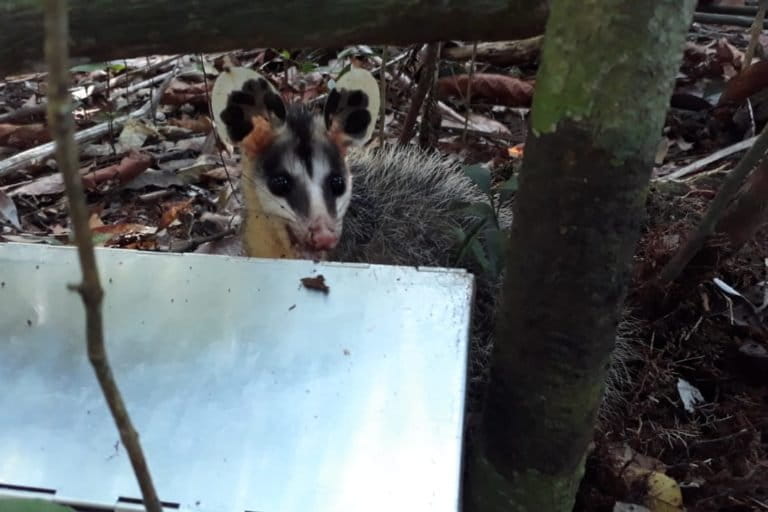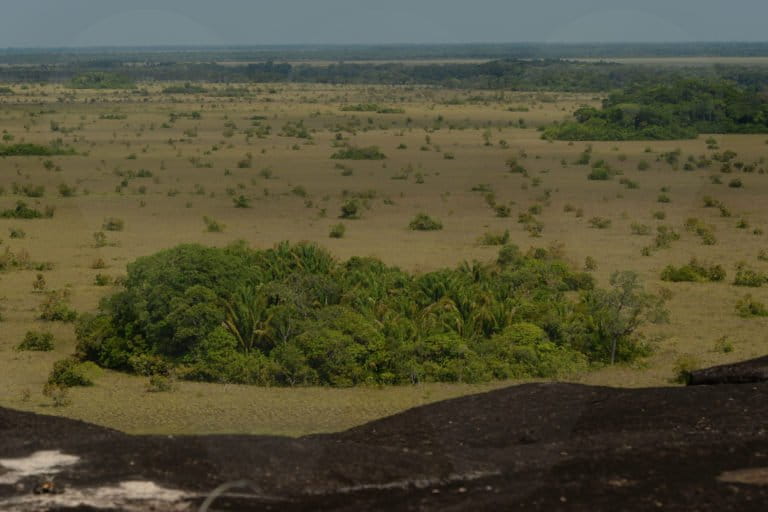- Forty-four camera traps have recorded various species in El Tuparro National Natural Park in Colombia’s Orinoco region, from jaguars and pumas, to deer, tapirs and peccaries, reflecting the park’s healthy ecosystems.
- A separate survey also recorded a Guianan white-eared opossum (Didelphis imperfecta), a species never before recorded in Colombia.
- The protected area has just turned 40 years old, and although it represents a rare conservation success story, rangers and researchers say it continues to face pressures from fires, sport and commercial fishing, and hunting.
- Compounding the problem is the growing human presence in and around the park, as the economic and political crises in neighboring Venezuela drives an influx of people across the border in search of food.
In the forests of El Tuparro National Natural Park, a protected area in the far east of Colombia’s Orinoco region, a jaguar roams freely, the king of a territory it shares with many other species. It was captured in a languid mid-stride pose on one of 44 camera traps set up around the park between January and May 2020 by park rangers and researchers from the Wildlife Conservation Society (WCS) and WWF. Other species picked up by the network of cameras: a puma (Puma concolor), ocelot (Leopardus pardalis), tapir (Tapirus terrestris) and peccaries (Tayassu pecari and Pecari tajacu).
These images are part of a large monitoring program and confirm that the food chain is still healthy in this ecosystem.
“All the top predators in the food chain, such as the jaguar, the jaguarundi [Puma yagouaroundi] and the forest fox [Cerdocyon thous], are found within El Tuparro National Natural Park,” said Jorge Parra, WCS’s protected areas coordinator. “This means that there is prey and that the park is fulfilling its function of maintaining ecosystems. Usually, these species are the first to disappear when there are severe disturbances.”
Every day, when the park rangers walk through the area, they come across animal tracks, including those of tapirs accompanied by their young, dozens of peccaries in search of watering holes, and pacas (Cuniculus paca), a giant rodent. These, and the visual evidence gathered by the camera traps, point to the park as a conservation success story.

Henry Pinzón, head of El Tuparro National Natural Park, said it was exactly 40 years ago that the Colombian government declared the territory a conservation area. The park comprises the core zone of El Tuparro Biosphere Reserve, an area that is home to ecosystems typical of the Orinoco region, with some of the country’s most scenic landscapes, such as the Maipures rapids, where the Tuparro River meets the Orinoco River and their waters rush around rock forms.
El Tuparro National Natural Park, which is almost 557,000 hectares (1.38 million acres) according to its latest delimitation, is home to dry and flood-prone savannas, gallery forests, terra firme forests (rainforests not inundated by flooded rivers), and even rocky outcrops. The park is deemed environmentally important, and researchers have dedicated years of study to analyzing possible threats to its ecosystems, including fires, sport and commercial fishing, and even hunting.
Growing human pressure
The camera traps recorded a tapir with an arrow lodged in its back walking through the forest. According to Pinzón, this image confirms that the Indigenous communities inhabiting the territory are continuing to hunt traditionally. But it also suggests that the demand for resources may be increasing; the Indigenous population within the park’s area of influence has increased by 300%.
Much of this population is concentrated in two large Indigenous reserves that were created in 2018 and overlap onto the protected area: the Awia Tuparro reserve is home to the Sikuani people, while the Nacuanedorro reserve hosts the Mapayerri Indigenous people, a community that only recently made contact with the outside world. Part of the reason for the swelling population is the influx from neighboring Venezuela of Indigenous peoples fleeing the economic and political crises there. Like other Indigenous peoples the world over, their historical range predates national boundaries, and their move from Venezuela into Colombia followed the same paths their ancestors took.


For now, the challenge for park rangers and WCS and WWF researchers is to find a balance that will ensure species richness and numbers are maintained, while guaranteeing food security for Indigenous communities.
Through the monitoring program that is under way, they aim to establish the current situation of the species typically hunted by Indigenous people, such as peccaries, tapirs and deer. “It is important to understand how they are using the fauna to guarantee its sustainability,” Parra said. He added the monitoring program is not just to understand the state of the fauna and flora, but acts as an integral strategy to analyze the pressures on resources and possible responses, and to inform any subsequent actions.
The 30 people involved in the program are now comparing the information collected in 2020 with that from 2015 to establish what has changed since then. “We want to help so that food resources do not run out for Indigenous people and [so that they can] try to use it in a more sustainable way, which means that we may have to reach an agreement on their usage. We are evaluating this,” Parra told Mongabay Latam.
In El Tuparro National Natural Park, which has savannas that become floodplains when the Tomo and Tuparro rivers overflow during the rainy season, there are more than 300 species of birds, four species of cat, as well as foxes, rodents such as the paca, capybara (Hydrochoerus hydrochaeris) and black agouti (Dasyprocta fuliginosa), the white-tailed deer (Odocoileus cariacou), red brocket (Mazama americana) and gray brocket (Mazama gouazoubira), and five species of turtle: the arrau turtle (Podocnemis expansa), the big-headed Amazon River turtle (Peltocephalus dumerilianus), the savanna side-necked turtle (Podocnemis vogli), the red-footed tortoise (Chelonoidis carbonarius) and the yellow-spotted river turtle (Podocnemis unifilis) — among the many other wild animals that make El Tuparro National Natural Park a jewel of the Orinoco region.


Fires burning out of control
The biggest challenge now facing El Tuparro National Natural Park rangers is the fires that occur throughout the year, mainly between January and March, the region’s hottest months. These fires are becoming increasingly frequent and, according to Pinzón, can endanger the park’s ecosystems. In the first quarter of 2020 alone, 86,121 hectares (212,810 acres) were burned, mainly in savannas. That’s larger than the 76,591 hectares (189,260 acres) burned in all of 2019.
“Most of the fires are of anthropogenic origin. They are connected to actors who think that the territory should be completely ‘clean,’” Pinzón said. Although the savannas, the main areas affected by the fires, can usually be renewed within a week, what greatly concerns the rangers are the reptiles that live in these ecosystems, as they have very reduced mobility. They are also concerned about nests in trees and gallery forests. “We don’t want the forest to become unsustainable,” Pinzón said.
Tania González, a biologist and doctoral student at the National University of Colombia and member of the university’s Landscape Ecology and Ecosystem Modeling (Ecolmod) research group, is researching the effects of fire on small mammals such as marsupials and rodents in the Orinoco region. Although her work does not focus on El Tuparro National Natural Park, she said fires are usually used throughout the region to clear land for agriculture and to stimulate the growth of fresh grass for livestock grazing. At first, the burning was limited to the dry savannas, but now the fires have gone out of control and are spreading to the interior of the forests, affecting plants and animals there too.


“Fires can affect animals both directly when it causes mortality, either from the flames or smoke, and indirectly when the vegetation they need for food or shelter dies,” González said. “This can happen in El Tuparro […] When animals are large, they escape and move on to colonize other areas, but when they are smaller and move less distances, the impact is usually greater, as can be the case with small mammals or amphibians and reptiles.”
During a survey conducted by González and other members of the research group in El Tuparro National Natural Park, they identified a Guianan white-eared opossum (Didelphis imperfecta) with two babies. This species had previously never been recorded in Colombia and was known only to exist in the lowland rainforests of Venezuela and parts of Brazil, Guyana, Suriname and French Guiana. This sighting, which was published in a study in June 2020, is very important for Colombia, as only two marsupial species of the Didelphis genus of opossums have been recorded in the country.
According to González, “Marsupials and rodents are very important because they are organisms that have key functions in ecosystems. They disperse seeds, consume seeds and move nutrients around the soil when burrowing. These activities are essential for vegetation to be maintained and for us to have oxygen.”

Indiscriminate fishing
Sebastián Mora, an environmental engineer and second-in-command at El Tuparro National Natural Park, said he’s most concerned about the threat from commercial and sport fishing. Park rangers commonly find people coming in from Venezuela with nets and other gear that can trap large quantities of fish. According to Mora, these illegal fishers have been spotted along the Tomo River, at the mouth of the Tuparro River, and at other points in the protected area, especially during the spawning season of some species, such as the bocachico (Prochilodus magdalenae), which occurs when the waters are high, between July and August.
“We make daily rounds to monitor and control [fishing activities]. We have seized some gear, such as nets, and at times we have had the support of the Colombian Navy,” Mora said, adding that significant effort goes into education to raise awareness in the communities.
Sport fishing is also a problem as the department of Vichada, where the park is located, has positioned itself as a tourist destination for this activity. Although fishing is not permitted in El Tuparro National Natural Park, fishers enter the protected area along the Tomo River until they reach its mouth, where there is a popular lagoon for this activity.


“From December to March, there is a high influx of fishers throughout the department, and these activities are increasingly closer to the park, both along the Tomo and Tuparro rivers and the Caño Tuparrito, bodies of water that are practically in the heart of the protected area,” Mora said. “We have controlled this with patrols and educational and outreach activities. We have also begun environmental sanctioning processes for people who carry out these activities and who have been caught committing the offense.”
Park head Pinzón said that while Vichada departmental authorities have designated certain areas for sport fishing, the problem is that the populations of large fish sought out by sport fishers have been significantly reduced. This then leads to them entering the protected area. “We want foreigners who come in summer to understand that sport fishing is not permitted in national parks,” Pinzón said.
Turtles and crocodiles under threat
In El Tuparro National Natural Park, efforts are focused on recovering some highly threatened species, including the critically endangered Orinoco crocodile (Crocodylus intermedius). According to Parra from WCS, this species once ranged across the entire Orinoco region, but many local populations have since been extirpated, leaving just a few in the department of Arauca and along the Duda River between La Macarena and Tinigua national parks. “The main cause of the disappearance of the Orinoco crocodile was the trade of its skin,” Parra said.
WCS is working with the Colombian national parks board and the Palmarito Foundation, a local conservation NGO, on a project to reintroduce the species into the park. So far, they have carried out two pilot projects, which have seen more than 50 young crocodiles released. “These crocodiles measure between 80 and 150 centimeters [2.6 to 5 feet], but they can grow up to 4 or 5 meters [13 to 16 feet]. We hope to establish a population,” Parra said.


Another conservation priority in El Tuparro National Natural Park are the Arrau and yellow-spotted river turtles, which are at risk due to consumption by local communities and disturbances to their nesting beaches. The Arrau, the largest river turtle in South America, is classified as critically endangered at the national level and is threatened by hunting, nest plundering, and commercialization in both the Amazon and Orinoco regions. The yellow-spotted river turtle, also listed as an endangered species in the country, also suffers from commercial exploitation and mass consumption of its eggs.
Ivonne Rodríguez, a research and monitoring professional at El Tuparro National Natural Park, said these species have traditionally been a source of meat and eggs for the Indigenous communities. But the lucrative market for turtle eggs has increased pressure on the species from both inside and outside the park. “The results are alarming. We are seeing a significant reduction of these two species,” she said.
In 2019, El Tuparro National Natural Park rangers recorded the looting of 252 yellow-spotted river turtle nests along the Tuparro River, and seven yellow-spotted river and Arrau turtle nests along the Tomo River. In 2020, rangers recorded 45 nests looted on beaches along the Caño Tuparrito stream and 99 on monitored beaches along the Tuparro River.


For now, rangers are reviewing the monitoring results to take action and establish agreements that seek to protect these species, while guaranteeing food security for the Indigenous communities.
Jewel of the Orinoco
“A territory as important as the Orinoco, especially the Orinoco River Basin, is very underrepresented in protected areas,” said Fernando Trujillo, director of the Omacha Foundation, a conservation nonprofit. He added that although El Tuparro National Natural Park can protect unique ecosystems in the region, its isolation makes it vulnerable to different situations, such as fires or illegal activities that can occur along the border region.
According to Trujillo, since 2010, as part of an exercise carried out with the Alexander von Humboldt Biological Resources Research Institute and other organizations, 21 urgent conservation areas were identified for the entire Orinoco basin. “Currently we have El Tuparro National Natural Park, El Tuparro Biosphere Reserve and the Bita River Basin in Vichada, which at just over 824,000 hectares [2.04 million acres] is the largest Ramsar site in the country. We need to protect them and this could be a unique opportunity to join conservation efforts so that we all move in the same direction,” Trujillo said.

Parra said ensuring El Tuparro National Natural Park maintains a good conservation status is important to preserving its unique ecosystems of plains and transition forests, “which have an impressive water dynamic” and which can contribute a lot to Colombia in its strategy to adapt to climate change. He and the other conservationists working in the area said that caring for this protected area will preserve a jewel of the Orinoco and, at the same time, guarantee the future of the communities who call this land their ancestral territory.
Banner image of sunset in El Tuparro National Natural Park, courtesy of WCS Colombia.
This article was first reported by Mongabay’s Latam team and published here on our Latam site on Sept. 28, 2020.
